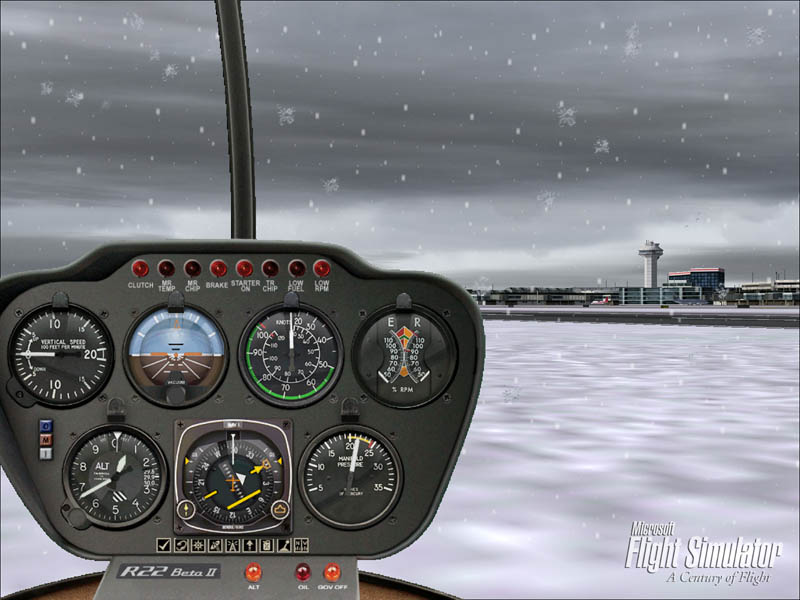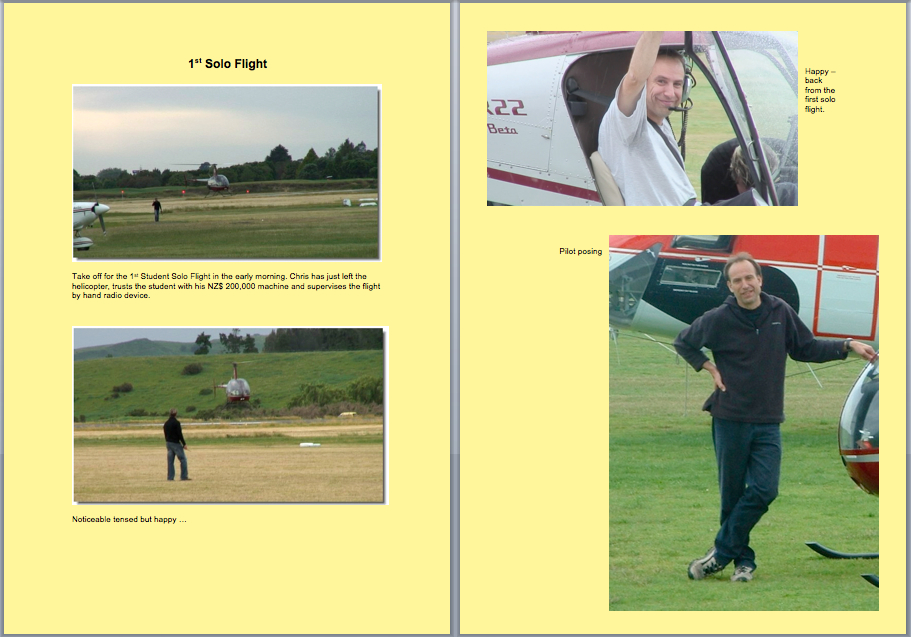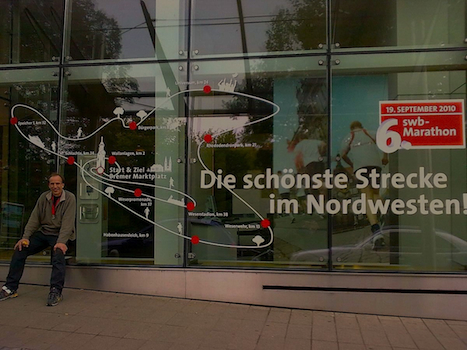| Flying |  |
On this page, you will find a few photo reports about the helicopter flight training in New Zealand, followed by a couple of further written reports in English and German (under construction).
Auf dieser Seite gibt es ein paar Bildberichte zu meiner Ausbildung zum Hubschrauberpiloten in Neuseeland; gefolgt von zwei weiteren Textberichten auf Englisch und Deutsch (in Vorbereitung).


13/03/2006
Report about the Helicopter Flight Training in Tauranga / New Zealand
Up to now I have done almost 50 flight hours. I could not believe it, but the most difficult task "hovering" worked by itself after a certain time. The secret seems to be to stabilise the cyclic control with a fixed right forearm, lying on the right knee, look outside on a reference point preferably far away and make very very short movements - never over control!
The next tasks were proper take-offs and landings. Landings on sand or soft grass are relatively easy, but to land nice and gently on the concrete is still an ongoing demand, especially in gusty conditions. Here, another trick is necessary: Do not try to land perfectly balanced with too many attempts to correct close to the ground (because there is always an air cushion underneath which makes it even harder!) but come to the ground uninterruptedly, speedy and very categorically.
A very particular experience was the 1st solo flight, of course. I actually did it as a spontaneous decision: Norbert, another German student from Munich, had just finished his 1st solo flight and I intended nothing but to record this event for him on his video camcorder in the early morning. Actually I admired his skills but I did not feel ready for the same event on this day. Originally, I intended to do it one week later or so. But everything went fine with Norbert, I was at the right place at the right time, the weather and air traffic conditions seemed to be perfect and he and the chief flight instructor Chris were the masters of motivation: "Come on, Roland, hop in, you can be the next!" I still declined but initially, we agreed in a spontaneous flight session. A series of take-offs and landings, a bit of hovering and taxiing alone on a special training area, one big circuit around the airport together with Chris, cleared to land and then he just jumped out ...! Okay, so I did three huge circuits at 1,000 feet around the controlled airport on my own. A great feeling and I was very happy. At the beginning of this flight it was actually like always. After a while I thought "There's not much to do ...!" and I was very surprised about this recognition. Indeed, I know, there IS a lot to do, but in this way I realised, that I was really relaxed (because the control movements have become automatic skills) and this was what it’s all about. Afterwards, Chris said I had done very well and with this I had reached a big step, probably about 50 % of the achievable knowledge and from today on I could call myself a pilot. But it might take years to reach the next 50 % ...
After our successful 1st solo flights, Norbert and I gave a big party with about 20 people.
In the meantime, I have done a few solo and cross country flights around our area, also above the sea, around peninsulas and so on. It is a great experience, of course ... When I fly alone it is strangely silent. Not a single comment, no complaints of the flight instructor due to little mistakes ... I enjoy it and I feel very privileged as well when I realise that not so many people have the possibility to fly and to see the whole space where people live, respectively landscapes and nature, from above ...
Until now, I have received my extensive medical licence for commercial pilots (inclusively two eye tests) and I have passed the radiotelephony operating exam so that I am authorised to speak to the tower in the controlled airspace here while flying alone. The next examination I have successfully sat was Human Factors and Aviation Medicine (for commercial pilots). This has actually been a particularly interesting topic to me as it involves a lot of psychology. Then I have passed the Air Law exam which has been a PPL (= Private Pilot License) exam only, but much harder for me than the one before. And last but not least I have got the minimum flight hours for the PPL practical final examination. Furthermore I was trained in a few advanced flying techniques, e. g. the commercial sling loading which is again much harder than a normal hovering. Imagine balancing a big bowl hanging on a thread over a defined spot (this is helicopter flying). But now you have got another weight on a further thread underneath which has to be balanced over a small spot and you can not look straight outside for a reference point anymore but you fly without door and look just vertical to position the load, e. g. a barrel filled with water which has not to be poured out …!
Looking back, another highlight was: I flew in a night flight frost protection operation over kiwi orchards and on the way to it and back to the base, I got the chance to fly the big 4-seater Robinson R44 in dark night conditions. I felt like being a pilot in one of those exciting polit-thriller movies. I was very impressed, how easy it is to get orientation while flying in a totally black night, presumed you have full moon, a clear starlit night and a lot of street lanterns and lighted houses …
The weather here is very hot. In the meantime it has become late summer and people are still swimming in the sea, so we’re flying quite a lot without doors. One day I have flown solo without doors left and right - a wonderful feeling ... Above the sea I followed a huge sting ray ...
But it is still a lot of work to finish what I set out to do regarding the flight training. Probably I have got 1/3 of everything now. Altogether I have got to sit about 13 several sorts of exams: 3 medical tests (that is already done), 7 theoretical exams (Flight Radio, Human Factors, Air Law, Meteorology, Navigation, General Aircraft Technology and Principles of Flight), the 1st solo flight mentioned above and the practical exams for the PPL and CPL (= Commercial Pilot Licence) after 150 flight hours. Once I have got all the theory exams, everything can go much more rapidly because then I can concentrate on the flying only and I could also fly a few times a day.
I would like to do a turbine rating as well to have the possibility to fly the bigger helicopters, which are operated in typical Search and Rescue operations. And if I wanted to earn money with my new developed skills, the hour building just starts after these 160 flight hours. At the beginning one can be grateful to get less well paid jobs because of the little flight experience. Another option is to do the instructor license training as well and to collect further valuable hours in this way. After 300 to 450 hours acceptably paid jobs are available and from 1,200 to 2,000 flight hours on one can get quite a lot of well paid jobs. For every new type of helicopter you intend to fly you will always have to do a special rating in a few hours with an advanced instructor.
But of course, everybody who knows me, knows that not only the flying is important to me. I have always been much more a generalist than a specialist and I actually have got many other things to do: Via e-mail I have written a scientific essay for a German student about biogas production sites in under-developed countries. I sat a three days Solar Heating Course at the Hamilton Technical University which qualifies us to install solar panels and the associated systems on New Zealand’s roofs. And I still have got my sideline job, my running training and - last mentioned but most important - my relationship.
Currently I am studying for “Meteorology and Weather to Fly”, the next examination subject.
A pros pos Search & Rescue Operation. In the middle of November, I have been involved in a real one for two whole days. This was one of the most interesting highlights here, even if it has had a sad end. Michael Erceg, liquor king and therefore one of the richest residents of New Zealand with an estimated fortune of more than NZ$ 620 million (!), started with his almost brand new Eurocopter from Auckland for a trip to the South Island in extremely bad weather conditions. After 45 minutes only, he and his co-pilot had been disappeared from the radar screens and missed. About 20 other helicopters have been searching for them or the helicopter wreck and I’ve been one of the observers on the back seat of “our” black Robinson R44. We’ve flown over native bush, paddocks, valleys and mountains all the time. I’ve got a deep impression how extremely difficult it can be to find just a rotor blade, protruding out of a huge forest for example … After more than two weeks (!) the wreck was found totally damaged and both pilots must have been dead directly after the impact.
Finally, something more positive:
One of my theory examiners was extremely nice. Following one examination we had a chat and shortly after we got to know each other, he invited us for a holiday stay for free at his weekend “bach” (NZ word for cottage) on the Coromandel Peninsula.The Coromandel area is well known as one of the country’s favourite landscapes with probably one of the ten most beautiful beaches all around the world …! More and more we experience here, this is a very typical behaviour of the Kiwis: one doesn’t need to pay for accommodation but everybody knows a friend of a friend in every town, where you can stay.
